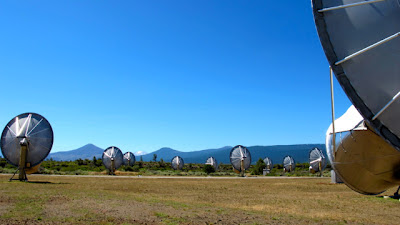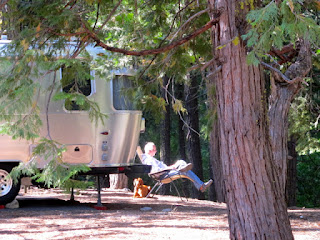Hat Creek Observatory, home to SETI
When we started planning our glamping adventure north I had an overwhelming desire to stand in the middle of Lassen Peak and Mt Shasta. How fitting that the only spot I found to accomplish my goal was at the Hat Creek Observatory, home to the nonprofit Search for Extraterrestrial Intelligence, or SETI, for short. Just 290 miles northeast of San Francisco at an elevation of 4200 feet, surrounded by pine forests and cattle ranches, the setting is strikingly beautiful and peaceful, albeit a bit spooky.
If the surreal setting above looks familiar to you, perhaps you remember it from Jody Foster’s movie, “Contact”, based on Carl Sagan’s novel. Foster’s character, Ellie Arroway, was inspired by Jill Tarter, the head astronomer-researcher at SETI. “Contact” was about an astronomer who finds a signal from outer space, has the equivalent of a mystical orgasm, and consequently redefines her spiritual beliefs. An entertaining story, but thus far, it remains a Hollywood fairytale.
Despite of the billions of NASA dollars spent probing space, there has not been a single peep anywhere in the galaxy that confirms DNA-based life beyond Earth. As humans, that leaves us cosmically alone in our struggle to answer “Does other life exist in the universe”?
Scientists know that there are as many planets - each with the possibility of life- as there are stars. Called the “Cosmic Haystack”, there are 100 billion stars to search and 9 billion narrowband radio channels listening for aliens to call Earth. That’s a lot of cosmic real estate. Jill Tarter told reporters that “The number two is the all important number. We count one, two, infinity. We’re all looking for number two.”
Lassen Peak with 2 of the 42 Allen Telescope Array listening for extraterrestrials
Picture me right here in the middle of Lassen and Shasta!
ATA facing north toward Mt Shasta
The Allen Telescope Array, pictured above, is designed to search the stars in order to find the alien in the Cosmic Haystack. The Allen Telescope Array (ATA), consisting of 42 antennas have been in place since 2007. The 42 dishes are named after Microsoft co-founder and philanthropist, Paul G. Allen, who gave $25 million to get the project rolling. The project was to consist of 350 antennas, 20 feet in diameter, and mass produced to look like satellite dishes. It seems Mr. Allen’s money was only enough for the existing 42. No one has stepped up to offer the additional $55 million required to complete the entire number. And that’s only the beginning of SETI'S financial difficulties.
When the recession struck, money for searching for alien life dried up. With recent budget problems and cutbacks, SETI’S partner, the University of California, Berkeley was forced to withdraw from the program. Since then, the radio dishes have been left standing dormant since April 2011. However, hope is on the horizon.
Low and behold, it turns out that the Allen Telescope Array, is just the thing that the US Air Force could use to track satellites and space junk! An infusion of a relatively small amount of money - $2.5 mil - will help get the antenna’s up and running, as well as pay the astronomers salary, for a few months. There has also been $220,000 worth of funding from private citizens from Silicon Valley, as well as, a contribution from Jody Foster!
ET, Better phone home, with your credit card!
In April 2012, SRI International came on aboard to oversee management at Hat Creek Observatory, and the ATA’s are due to be fired up this September. For the time being, it seems the Allen Telescope Array will once again be scanning the heavens for “technosignatures” or electromagnetic signals that could detect intelligent alien civilization.
Whoaaa, is it possible? Have Aliens landed at Hat Creek?
These friendly creatures aren't talking.
These folks have not landed from outer space, they are the wild creations of a local welder, who greet travelers on the road between Hat Creek and Cassel.































